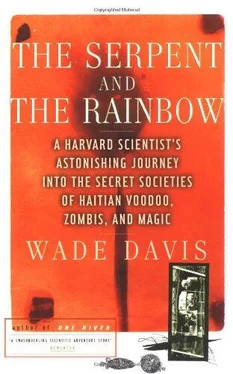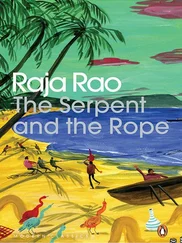Wade Davis - The Serpent and the Rainbow
Здесь есть возможность читать онлайн «Wade Davis - The Serpent and the Rainbow» весь текст электронной книги совершенно бесплатно (целиком полную версию без сокращений). В некоторых случаях можно слушать аудио, скачать через торрент в формате fb2 и присутствует краткое содержание. Год выпуска: 1985, Издательство: Simon & Schuster, Жанр: Старинная литература, на английском языке. Описание произведения, (предисловие) а так же отзывы посетителей доступны на портале библиотеки ЛибКат.
- Название:The Serpent and the Rainbow
- Автор:
- Издательство:Simon & Schuster
- Жанр:
- Год:1985
- ISBN:нет данных
- Рейтинг книги:5 / 5. Голосов: 1
-
Избранное:Добавить в избранное
- Отзывы:
-
Ваша оценка:
- 100
- 1
- 2
- 3
- 4
- 5
The Serpent and the Rainbow: краткое содержание, описание и аннотация
Предлагаем к чтению аннотацию, описание, краткое содержание или предисловие (зависит от того, что написал сам автор книги «The Serpent and the Rainbow»). Если вы не нашли необходимую информацию о книге — напишите в комментариях, мы постараемся отыскать её.
The Serpent and the Rainbow — читать онлайн бесплатно полную книгу (весь текст) целиком
Ниже представлен текст книги, разбитый по страницам. Система сохранения места последней прочитанной страницы, позволяет с удобством читать онлайн бесплатно книгу «The Serpent and the Rainbow», без необходимости каждый раз заново искать на чём Вы остановились. Поставьте закладку, и сможете в любой момент перейти на страницу, на которой закончили чтение.
Интервал:
Закладка:
It was a good thing I did, for Holmstedt had written a large portion of it. I reviewed briefly the hypothesis I had come up with, and explained that there was no evidence that the plant had reached Haiti.
“A good hypothesis is never wasted. Now what else have you got?”
“Albizzia lebbeck . The Haitians call it tcha-tcha. It’s a native of West Africa introduced into the Caribbean some years ago as an ornamental shade tree.”
“You may be onto something there. What did you find out about it?”
“The bark and seedpods contain saponins. In small concentrations quite effective as a vermifuge. But dosage is critical.”
“Isn’t it always?” said Kline.
“Some West African tribes use the plant as an insecticide or fish poison,” I said.
“How’s it work on fish?” Marna asked.
“They put the crushed seeds in shallow bodies of water. The saponins act on the gills to interfere with breathing. The fish suffocate, float to the surface, and the people gather them up. Doesn’t affect the meat.”
“You will find that killing a mammal with saponins is somewhat more complicated,” Holmstedt said. “But it can be done. In East Africa, the roots of Albizzia versicolor make a bloody fine arrow poison. But it’s no good putting it in someone’s food. Saponins aren’t absorbed by the intestines. You’ve got to get the stuff into the blood.”
“But isn’t that what they say they do in Haiti?” Marna asked.
“Yes,” I replied, “through the skin. Professor Holmstedt, what are the symptoms of saponin poisoning?”
“In sufficient dosage, nausea, vomiting, eventually excessive secretions into the respiratory passages. In simpler terms, the victim drowns in his own fluids.”
“With pulmonary edema as an interim result?” I asked.
“Yes, of course.” It was the condition that headed my list of Clairvius Narcisse’s symptoms at the time of his death.
“You will find that Albizzia has one more secret,” Holmstedt went on. “Many species of the genus contain a special class of compounds known as sapotoxins that are absorbed by the intestines. They work in a rather nasty fashion by interfering with cellular respiration throughout the body. They kill you by actually weakening your every cell. Incidentally, the Efik traders of Old Calabar used the bark of Albizzia zygia in a potion known as ibok usiak owo , which means in their language ‘a medicine for mentioning people’—a sort of native truth serum, I would say. They administer it orally as an ordeal poison. You see, Wade, you come back full circle to your hypothesis.”
“Have you got anything yet on these lizards and toads and whatever else they put in?” Kline asked.
“Nothing encouraging,” I replied. “There’s a polychaete worm that Marcel sequesters with the toad. It had bristles on it that some say inflict a mild paralysis. They may be venomous, but the reports are vague. The herpetologists up at the museum knew the lizards right away. Neither is known to be poisonous. In Dominica, they say one of them can make the hair fall out and turn your skin green. But the people eat it anyway. Another species in a related genus plays havoc with housecats in Florida, but it doesn’t kill them. But it wasn’t a lizard that took down Narcisse, that’s for sure.”
“What about the toad?” Holmstedt asked.
“Bufo marinus.”
“You’re certain.”
“It’s unmistakable. The people at Herpetology confirmed it.”
Holmstedt paused to consider. “Quite,” he said finally, and looking straight at me, “Wade, I’d say you’re onto something.”
The next morning when I returned to Cambridge, there was no new information for me. The first botanical determinations did show that Marcel Pierre was exploiting plants with both pharmacologically active compounds and proven African connections, but isolated reports drawn from over half a continent explained very little. The Calabar hypothesis, despite Holmstedt’s words of encouragement, seemed to have led me nowhere. I had found no evidence of the Calabar bean in Haiti, and while datura had been present, its connection to the zombi phenomenon remained uncertain.
It was discouraging, but my luck would change by the end of the day. The more I read about the large bouga toad, the ingredient that had so caught Holmstedt’s interest, the brighter my mood became. I learned that the paratoid glands on its back are virtual reservoirs of toxic compounds.
Although Bufo marinus is a native of the New World, it apparently reached Europe very soon after the voyages of Columbus, and there it was well received by nations long familiar with toad venom. Europeans believed that toads derived their poisons from the earth by eating mushrooms (hence the English name toadstool) . As early as Roman times, women used toads to poison their husbands. Soldiers in the Middle Ages believed that a discreet means of wounding an enemy was to rub his skin with the secretions of Bufo vulgaris , the common European species. And not long after Bufo marinus reached the Old World, poisoners found that by placing the toad in boiling olive oil, the secretions of the glands could be easily skimmed off the surface. In Italy early in the sixteenth century, poisoners devised sophisticated processes for extracting toad toxins into salt, which could then be sprinkled on the intended victim’s food. In fact, so highly regarded was the toxicity of toad venom that at the beginning of the eighteenth century it was actually added to explosive shells. Presumably the commanders felt that if the cannon did not kill their enemies, the toad toxins would.
The toxic properties of toads had certainly not been overlooked by the natives of the Americas. The Choco Indians of western Colombia, for example, learned to milk poisonous toads by placing them in bamboo tubes suspended over open flames. The heat caused the creature to exude a yellow liquid, which dripped into a small ceramic vessel where it coagulated into the proper consistency of curare, the arrow poison. According to an early and perhaps exaggerated report, these preparations were extremely potent; a deer struck by an arrow survived two to four minutes, a jaguar perhaps ten. Of course, arrow poisons work in many different ways. Those based on the lianas of the northwest Amazon act as muscle relaxants, causing death by asphyxiation. The skin of Bufo marinus , on the other hand, contains chemical substances resembling the strongest of the African arrow poisons. These latter are derived from a plant, Strophanthus kombe , and they act in a quite different way. The active principle is a chemical called ouabain, and it is a powerful stimulant of the muscles of the heart. In moderate dosage ouabain is used today to treat emergency heart failure; in excessive doses it makes the heart go crazy, pumping wildly until it collapses.
Not surprisingly, European physicians incorporated toad venom into their materia medica at a very early point, and in fact powdered toad remained a prominent therapeutic agent well through the eighteenth century. But as in so many things, the Chinese were far ahead. For centuries they had been forming the venom into round, smooth dark disks, which they named ch’an su , or “toad venom.” According to the Pentsao Kang Mu , a famous herbal written at the end of the sixteenth century, the venom was used to treat toothache, canker sores, inflammations of the sinus, and bleeding of the gums. Taken orally as a pill, it was said to break up the common cold.
From this list of rather mundane afflictions, it is difficult to appreciate that the Chinese were dealing with an extremely toxic preparation. When ch’an su was analyzed early in this century it was found to contain among other active principles two powerful heart stimulants known as bufogenin and bufotoxin.
Читать дальшеИнтервал:
Закладка:
Похожие книги на «The Serpent and the Rainbow»
Представляем Вашему вниманию похожие книги на «The Serpent and the Rainbow» списком для выбора. Мы отобрали схожую по названию и смыслу литературу в надежде предоставить читателям больше вариантов отыскать новые, интересные, ещё непрочитанные произведения.
Обсуждение, отзывы о книге «The Serpent and the Rainbow» и просто собственные мнения читателей. Оставьте ваши комментарии, напишите, что Вы думаете о произведении, его смысле или главных героях. Укажите что конкретно понравилось, а что нет, и почему Вы так считаете.












